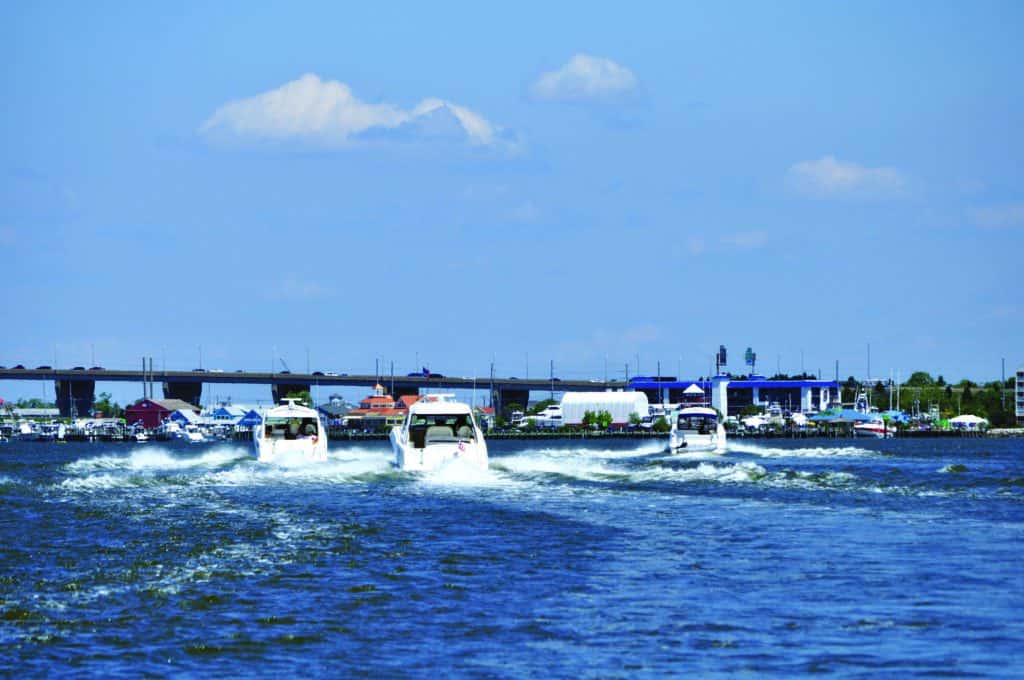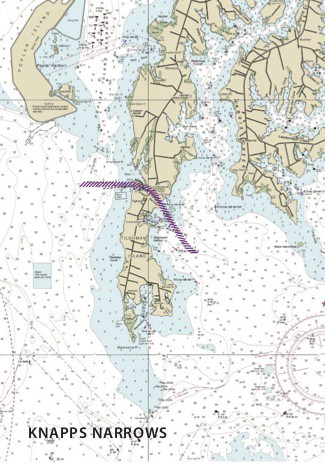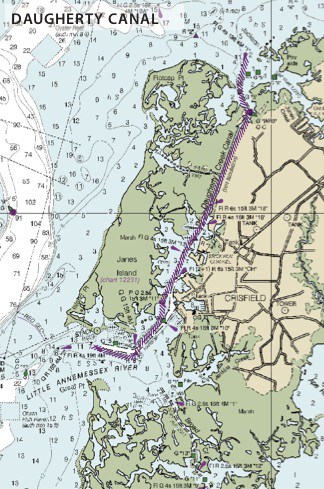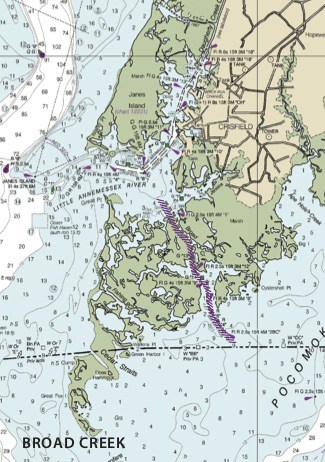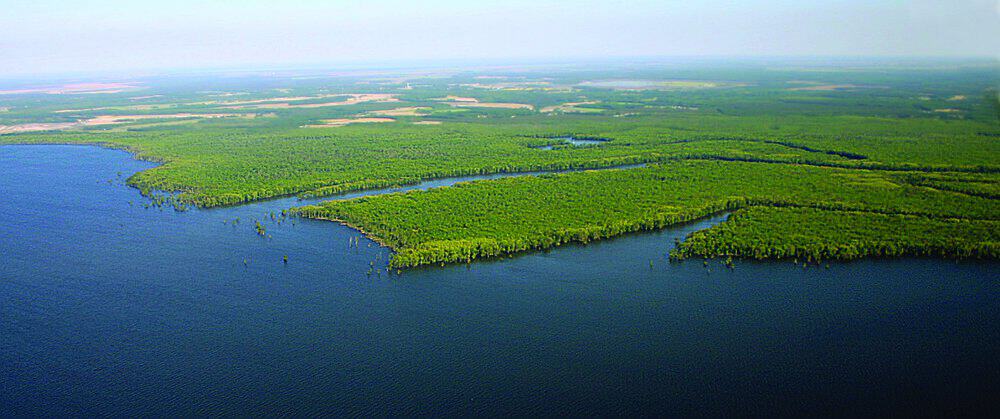How to Buckle Your Swash
This is a piece about shortcuts that you can take, under the right circumstances, while boating on the Chesapeake.
I am crazy about shortcuts and will sometimes go miles out of my way just to use one—the Daugherty Canal for example. But more on that later. Some people drive miles out of their way to visit teepee-shaped motels or Sinclair Oil stations shaped like dinosaurs. My taste just runs to shortcuts, which I feel at least serve some purpose. My two-part definition of a shortcut is a route that saves time and distance, but also includes an element of uncertainty. That is, you might or might not make it through. It’s a bit of a gamble, see. Sound like fun? Read on.
The “Piece of Cake” Shortcuts
Let’s start with a couple of pretty easy shortcuts that nearly all of you already know. This is also where I lull you into a false sense of security.
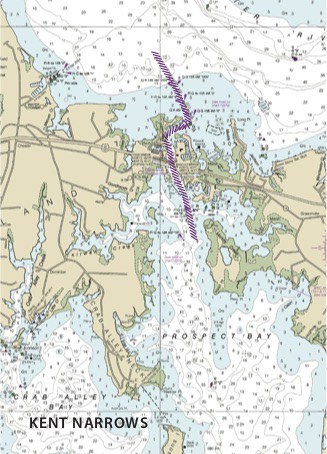
Kent Narrows
See? You know this one and have very likely already used it. This shortcut makes it easy to get from Eastern Bay to the Chester River, saving a whopping 20 miles. This route also includes a treasure trove of restaurants, marinas and dock bars. The channel itself is straight-forward and well-marked.
What’s the challenge? The Chester River side of the Narrows is famous for shoaling, as the current pushes sand and silt around like an underwater bulldozer. Shoaling usually begins around the upriver-side green markers. The good news is that the Army Corps of Engineers does its own bulldozing every few years, usually before the shoaling gets too bad. This was last done in the fall of 2018.
There are two bridges, one is fixed at 65 feet and the second is a bascule with a closed clearance of 18 feet. During the season, the bridge will open on the hour and half-hour. Finally, the red-green nav aids change sides at the bascule bridge.
Knapps Narrows
Here’s another well-known mid-Bay cut-through, this one between the Bay and the Choptank River. Cruisers coming from the south are more likely to use the river’s entrance, but those traveling down from Annapolis, Baltimore, Rock Hall and points north, as well as those crossing from Herring Bay benefit from this shortcut. This route is so well used, in fact, that the Knapps Narrows bascule bridge with a 12-foot vertical clearance is said to be the busiest drawbridge in the nation, with an average of 10 thousand openings a year, or nearly 30 a day. The bridge opens on demand.
The Narrows saves a modest six miles if you’re headed upriver to Oxford or Cambridge, more if you are going up to Dunn Cove for the night. But it also allows boaters to avoid the current and chop that often make the river entrance a contest of wills.
Like Kent Narrows, Knapps offers restaurants and marinas along the passage. And like Kent, the Knapps channel is vulnerable to shoaling, especially on the Bay side. The good news is that Knapps was dredged in the spring of 2018, so for 2019 and 2020 boats up to six feet draft should be fine.
Navigation markers switch just west of the bridge.
York Swash Channel
The most commonly used shortcut in the southern Bay is probably the York Swash Channel, which cuts through the long York River Spit at the mouth of the York, creating a quicker route to any destination north along the Western Shore, particularly Mobjack Bay.
A swash is a passage through a sandbar or beach. Interestingly, it also means to act in a boastful, swaggering manner as in a swashbuckling pirate. Maybe swashbucklers were people who self-congratulated for cutting across dangerous sandbars. Whatever—this is a swash, and if you successfully cross it, you can swashbuckle at your next club party too.
Challenges to navigating the York Swash include dealing with a very skinny channel of deep water, so keep watch ahead and behind to make sure you are not drifting wide. The other issue is that you’ll often find that a navigational aid or two has gone AWOL due to the exposed nature of the waters off the York, which is open to winds and seas off the open ocean in an easterly to southeasterly blow and the full length of the Chesapeake in a northerly. But other than that, you should be good.
The “Interesting” Shortcuts
We now arrive at the flip-a-coin category of shortcuts. My favorites! In other words, you might make it; you might not. Assuming you can follow a channel like it’s your job, your success now depends almost entirely on depth. And depth, like Caesar’s Gaul, is divided into three parts: how much your boat draws, where you are in the tide cycle, and whether the wind has been blowing water into or out of your shortcut. Once you have weighed all that in the balance and the omens are favorable, you can proceed. But, unless you draw only slightly more than a rubber duck, do so slowly and carefully. Be ready to hunt and peck for the channel if the depth begins to look alarming. And remember, worse case, you got that far, so you can always turn around and retrace your steps. Tip: Turn on your tracker before you start.
Daugherty Canal
With that cheery prelude, let’s look at Daugherty Canal, which you are going to want to put on your list of must-do-if-you-can-do, which is likely to run in the four-foot ballpark for a bit at the northern end.
The Daugherty Canal is a short cut between the Big Annemessex and Little Annemessex rivers. What? Well, to orient you, Crisfield is on the Little Annemessex River, and the Daugherty comes out right in its backyard. That still doesn’t explain why it exists—perhaps the Corps of Engineers got a new dredge in 1939—but nevertheless it’s pretty cool. First, it gets you to Janes Island State Park, where you can take your dinghy and explore miles and miles of wild beach along Tangier Sound and miles and miles of trails. Bring a lot of mosquito repellant. And it gets you easily to and from Crisfield, which is a good place to visit too.
If you are coming from the north, come into Tangier Sound by way of Hooper Island Strait and head south until you get to the Big Annemessex River. It’s just south of the Manokin River, which you’ve probably never heard of either. Make for the south shore of the Big Annemessex and look for the channel markers about a mile and a half upriver. The markers soon split left and right. Be sure to take the right channel. You will definitely not float your boat if you go the other way. (I am speaking from experience here.) From there, you are only about three miles from Crisfield. After the shallow bit I mentioned earlier, the water will be six to eight feet deep, though the channel is narrow, narrow, narrow at the south end. Also, the markers change sides about half-way through, as does the current direction, which is slightly disconcerting. You’ll see what I mean. That’s all there is to it. But be sure to soak up the beauty of the wide wild marshes as you pick your way through.
Broad Creek
This is a perfectly lovely shortcut if you are traveling between Crisfield and the Pocomoke River or even Crisfield and Onancock because it cuts out the trip you otherwise have to make out and around Watts Island. Watermen use Broad Creek all the time, and it’s well marked. The hitch is, the bottom is constantly in flux, so you can never be absolutely sure the deep water will be where it’s supposed to be, especially on the north, or Crisfield, end.
This spring, as I was coming out of the Pocomoke River I could see ahead that Pocomoke Sound was an Alabama cotton crop of wind-blown foam. It was going to be a miserable 16-mile slog out to Watts Island before I could turn north on Tangier Sound for the 12-mile leg up to Crisfield. So, I called Crisfield Towboat US and asked Chris Parker whether he thought I could make it through Broad Creek. Broad Creek is about 10 miles from the Pocomoke River entrance and then only another five miles to Crisfield. Now that’s a shortcut! I gave Parker my draft, which is just under 4 feet, and he considered a minute and then replied, “Well, the channel changes every day, but yes, you probably can make it.” That was good enough for me.
I left the Pocomoke channel halfway between green “9” and red “8” and headed north to Broad Creek’s outboard marker, red “2bc”. Up the channel I went, warily watching my depth sounder. To be honest, I can’t really tell you what the creek looked like, because all my attention was on the channel markers and the depth sounder.
About half-way through, the markers stopped, but the water continued comfortably deep. As I reached the north end and the final marker, green “1” which now marked the opposite side of the channel, the depth read five and a half before returning to six just before I reached the Crisfield channel. Done!
The “Don’t Be Silly” Shortcuts
Here are some shortcuts you are unlikely or ill-advised to take unless you are a local and know how it’s done, or you are a visitor in a rubber-duck-type craft, and you are following a local. Most of these have both shallow water and low bridges; some have shallow, restless channels though no bridges. Most have local navigation marks, since the Coast Guard has long since thrown up its hands over the situation.
Hole in the Wall
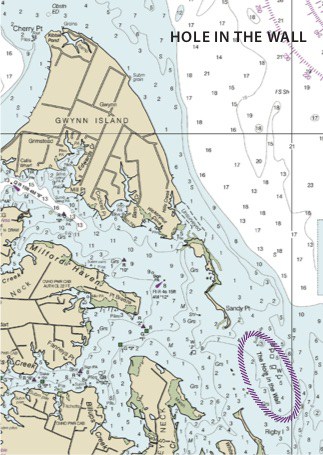
This is the famous, or more accurately infamous, shortcut across the shoals between Milford Haven and the Bay. It is also the shortcut I would most like to do someday, partly because it’s there, as Mallory said of Everest, and partly because it cuts off a sizeable amount of time and 10 miles, if you happen to find yourself in Milford Haven visiting Gwynn’s Island and want to head south down the Bay. Or if the Milford Haven bascule bridge is out of order—which is not unheard of.
It is probably possible to get through Hole in the Wall with a draft of four feet or so, but it would take a calm day and Job-level patience. There are private marks, but shoals often extend into the channel beyond them. Tip: Pay up your towing insurance.
Honga River
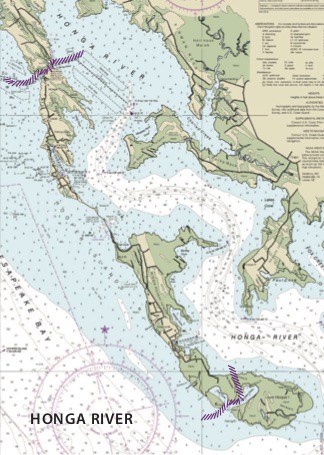
The Honga River, which feels utterly and completely like the end of the world, would likely be a much more popular spot for anchoring if there were a way to cut between the Honga islands. “Is there any way to cut through from the Honga back to the Bay?” I am asked with surprising frequency. “Nope,” I reply. There are, in fact, two cut-throughs used by locals. One is a shoal-draft channel between Upper Hooper Island and Lower Hooper Island, and the other, slightly deeper one, is between Upper Hooper Island and the mainland. This second course is marked with PVC posts of uncertain interpretation and is crossed by a 24-foot fixed bridge. The preferred route is to go out the way you came in, which is around the bottom of Lower Hooper Island.
The Sandbox
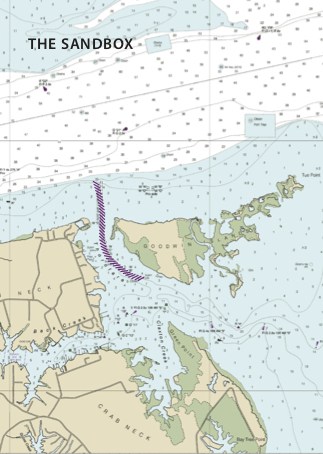
This is the old shortcut to Back Creek off the York River. It is marked with private aids to navigation, though it is no longer dredged. I’m not recommending it, though I’m sure locals use it with impunity. It does cut off about five miles over the usual trip around the Goodwin Islands shoal.
The Others
There are a few other limited-use shortcuts on the Bay, but these are up one river or another, so I’ll just mention them here. There is a fairly usable one if you can get under a 17-foot bridge between St. George Island and the Potomac River, and there are a couple of unrestricted thoroughfares on the Pamunkey River at the top of the York and the Chicahominy River off the James. I know you are unlikely to visit either, but you should, especially the Chicahominy, which is like no other river on the Chesapeake. I won’t mind if you don’t even to take the shortcut.

